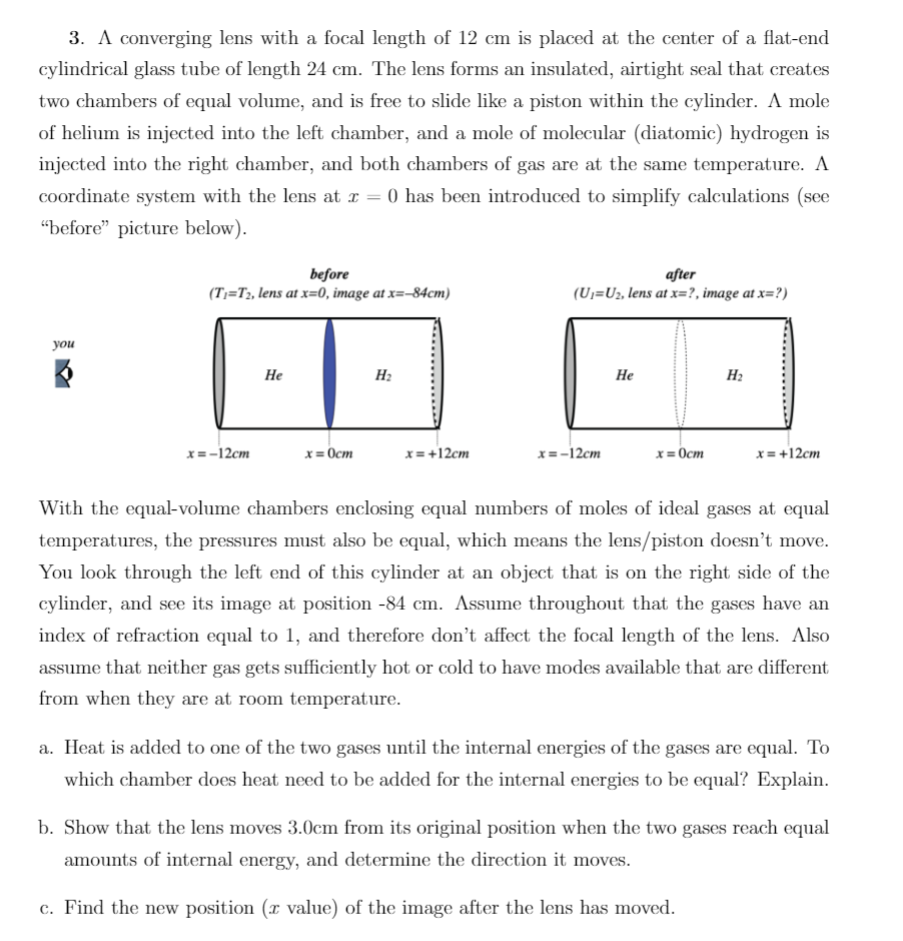3. A converging lens with a focal length of 12 cm is placed at the center of a flat-end cylindrical glass tube of length 24 cm. The lens forms an insulated, airtight seal that creates two chambers of equal volume, and is free to slide like a piston within the cylinder. A mole of helium is injected into the left chamber, and a mole of molecular (diatomic) hydrogen is injected into the right chamber, and both chambers of gas are at the same temperature. A coordinate system with the lens at x = 0 has been introduced to simplify calculations (see "before" picture below). you before (T₁=T₂, lens at x=0, image at x=-84cm) x=-12cm He x=0cm H₂ x=+12cm after (U₁=U₂, lens at x=?, image at x=?) x=-12cm He x=0cm H₂ x=+12cm With the equal-volume chambers enclosing equal numbers of moles of ideal gases at equal temperatures, the pressures must also be equal, which means the lens/piston doesn't move. You look through the left end of this cylinder at an object that is on the right side of the cylinder, and see its image at position -84 cm. Assume throughout that the gases have an index of refraction equal to 1, and therefore don't affect the focal length of the lens. Also assume that neither gas gets sufficiently hot or cold to have modes available that are different from when they are at room temperature. a. Heat is added to one of the two gases until the internal energies of the gases are equal. To which chamber does heat need to be added for the internal energies to be equal? Explain. b. Show that the lens moves 3.0cm from its original position when the two gases reach equal amounts of internal energy, and determine the direction it moves. c. Find the new position (z value) of the image after the lens has moved.
3. A converging lens with a focal length of 12 cm is placed at the center of a flat-end cylindrical glass tube of length 24 cm. The lens forms an insulated, airtight seal that creates two chambers of equal volume, and is free to slide like a piston within the cylinder. A mole of helium is injected into the left chamber, and a mole of molecular (diatomic) hydrogen is injected into the right chamber, and both chambers of gas are at the same temperature. A coordinate system with the lens at x = 0 has been introduced to simplify calculations (see "before" picture below). you before (T₁=T₂, lens at x=0, image at x=-84cm) x=-12cm He x=0cm H₂ x=+12cm after (U₁=U₂, lens at x=?, image at x=?) x=-12cm He x=0cm H₂ x=+12cm With the equal-volume chambers enclosing equal numbers of moles of ideal gases at equal temperatures, the pressures must also be equal, which means the lens/piston doesn't move. You look through the left end of this cylinder at an object that is on the right side of the cylinder, and see its image at position -84 cm. Assume throughout that the gases have an index of refraction equal to 1, and therefore don't affect the focal length of the lens. Also assume that neither gas gets sufficiently hot or cold to have modes available that are different from when they are at room temperature. a. Heat is added to one of the two gases until the internal energies of the gases are equal. To which chamber does heat need to be added for the internal energies to be equal? Explain. b. Show that the lens moves 3.0cm from its original position when the two gases reach equal amounts of internal energy, and determine the direction it moves. c. Find the new position (z value) of the image after the lens has moved.
Related questions
Question

Transcribed Image Text:3. A converging lens with a focal length of 12 cm is placed at the center of a flat-end
cylindrical glass tube of length 24 cm. The lens forms an insulated, airtight seal that creates
two chambers of equal volume, and is free to slide like a piston within the cylinder. A mole
of helium is injected into the left chamber, and a mole of molecular (diatomic) hydrogen is
injected into the right chamber, and both chambers of gas are at the same temperature. A
coordinate system with the lens at x = 0 has been introduced to simplify calculations (see
"before" picture below).
you
before
(T₁=T2, lens at x=0, image at x=-84cm)
x=-12cm
He
x=0cm
H₂
x=+12cm
after
(U₁=U₂, lens at x=?, image at x=?)
x=-12cm
He
x=0cm
H₂
x = +12cm
With the equal-volume chambers enclosing equal numbers of moles of ideal gases at equal
temperatures, the pressures must also be equal, which means the lens/piston doesn't move.
You look through the left end of this cylinder at an object that is on the right side of the
cylinder, and see its image at position -84 cm. Assume throughout that the gases have an
index of refraction equal to 1, and therefore don't affect the focal length of the lens. Also
assume that neither gas gets sufficiently hot or cold to have modes available that are different
from when they are at room temperature.
a. Heat is added to one of the two gases until the internal energies of the gases are equal. To
which chamber does heat need to be added for the internal energies to be equal? Explain.
b. Show that the lens moves 3.0cm from its original position when the two gases reach equal
amounts of internal energy, and determine the direction it moves.
c. Find the new position (r value) of the image after the lens has moved.
Expert Solution
This question has been solved!
Explore an expertly crafted, step-by-step solution for a thorough understanding of key concepts.
This is a popular solution!
Trending now
This is a popular solution!
Step by step
Solved in 4 steps with 3 images
